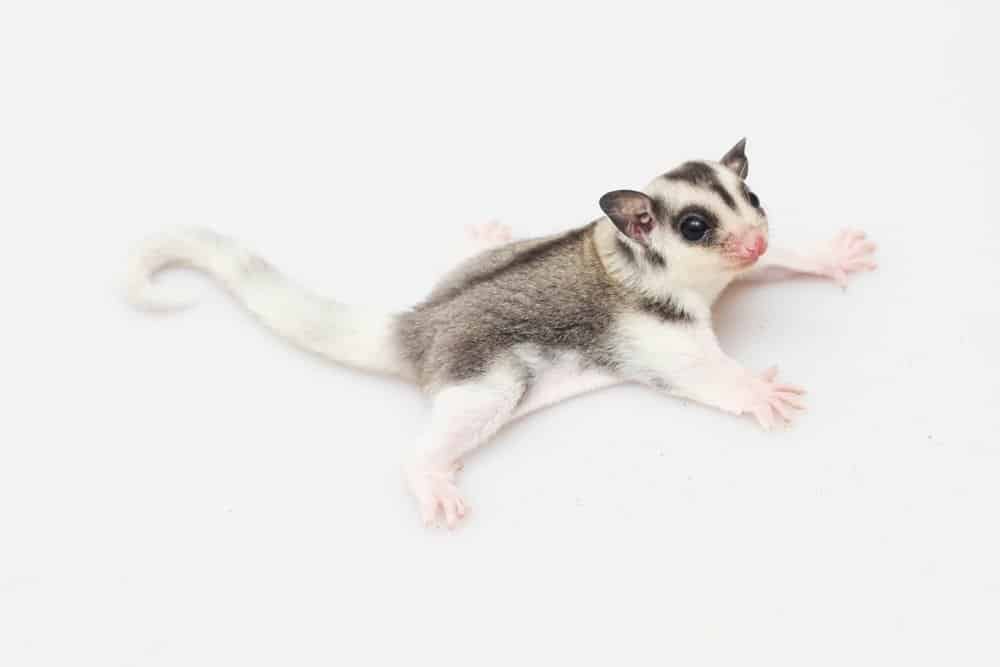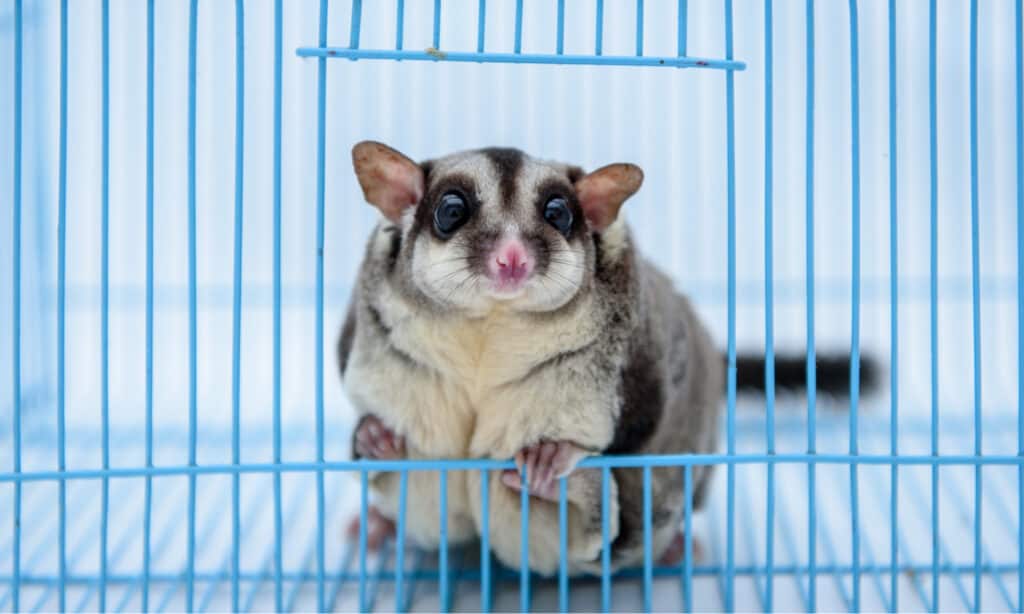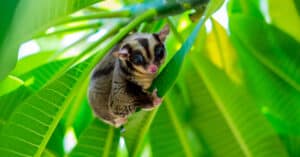Do these adorable creatures exhibit more activity during the day, or are sugar gliders nocturnal, meaning their busy times are at night? A sugar glider’s sleep behavior can vary depending on diverse factors. In this post, we look at what scientific research reveals. We learn more about the sleep behavior of sugar gliders and what it means for their health and welfare.
What Are Sugar Gliders?

Science tells us that
sugar gliders
are nocturnal, arboreal marsupials that sleep up to 15 hours daily.
©bluedog studio/Shutterstock.com
The sugar glider is a unique and fascinating animal. With its small size, arboreal lifestyle, and nocturnal foraging habits, it shares many similarities with other marsupials, such as the opossum and the kangaroo. However, what truly sets this tiny creature apart is its remarkable ability to glide through the air using a stretchy membrane that extends from its limbs. This gliding ability allows it to travel quickly and gracefully between trees, making it an expert navigator of the forest canopy.
The Nocturnal Sugar Gliders Sleep Behavior
Although sugar gliders are primarily nocturnal, their sleep behavior is not straightforward. They sleep about 15 hours in a 24-hour cycle. And scientific research shows that sugar gliders exhibit nocturnal and diurnal sleep patterns that depend on light levels and social interactions.
For example, sugar gliders often rest during the day in dark, quiet places out of sight from predators. At night, however, many of these gliders become more active and forage for food in search of their favorite treats, like sap and nectar. However, they take short naps in the darkest hours, with the most activity after sunset and just before sunrise. This activity pattern tends to be more pronounced during breeding season or when raising their young.
Captivity Influences Sugar Gliders Sleep
Many people love sugar gliders as pets, but one of the biggest challenges with caring for these tiny marsupials is understanding their natural sleep patterns. Sugar gliders are nocturnal animals, meaning they generally prefer to stay awake for much of the night and sleep during the day. However, it is possible to train them to adapt more to your sleeping schedule, which may not be in their best interest from a biological perspective.
Studies show that captivity can disrupt standard sugar glider sleep patterns, leading to brain chemistry and behavior changes. For example, captive sugar gliders are more active during the daytime than their wild counterparts. This behavior is possibly in response to increased stress levels or different environmental conditions.
To help ensure that your sugar gliders have enough sleep, you must provide a safe space where they can rest undisturbed. It is essential to minimize external disturbances like bright light and overhandling. Understanding sugar glider biology and providing proper care can help these animals thrive physically and psychologically.
How Does Bright Light Affect Nocturnal Sugar Gliders?

It’s important to remember that sugar gliders are
wild animals
and should be treated as such – even if they live in captivity.
©MARVIK/Shutterstock.com
One common concern is whether or not exposure to bright light will hurt sugar glider eyes or negatively affect their biological activity. Based on current research, the answer is yes – prolonged exposure to bright light can cause eye damage in these animals and impact their activity and sleep cycles.
It’s important to remember that sugar gliders are wild animals and should be treated as such – even if they live in captivity. So, if you’re thinking of getting a sugar glider or already have one, research how to care for them correctly. This care includes choosing the proper light bulb to illuminate their home.
Stay away from blue light sources, as they are incredibly disruptive and stressful for sugar gliders – not to mention potentially harmful to their health. Red light is also disruptive, but to a lesser extent than blue light. The best option for sugar gliders is infrared illumination (IR), which has no adverse effects on their behavior. So, if you want to properly care for your sugar glider, choose the right type of light in and near its cage.
Sugar Gliders Nocturnal Vision and Sight in Its Natural Habitat
Sugar gliders have a unique, highly specialized nocturnal vision that allows them to see well in their natural habitat. With large, protruding eyes set wide apart on their tiny faces, these animals can easily see all around them with a wide field of view. Their excellent nocturnal vision allows sugar gliders to navigate and forage for food at night.
Their eyes are dark brown, and they see the world only in shades of gray, with the added ability to detect the color red. In addition, they can excrete a milky substance from their tear ducts to help them clean and groom their eyes. Sugar gliders have eyesight perfectly adapted for navigating and thriving at night in the wild.
The Benefit of Smell in the Sugar Glider
Sugar gliders are well known for their excellent vision and agile movement. Still, perhaps less well-known is their highly developed sense of smell. This sense is vital in helping them find food, sense predators, and recognize other family members.
Sugar gliders use their incredibly sensitive noses to track down ripe fruits and sap, which form a large part of their diet. At night, they can even use scent to detect animals hiding underground.
Besides providing nourishment, sugar gliders’ keen olfactory senses also help protect themselves from potential nocturnal predators. By sensing smells in the environment before they venture out into the open, they can avoid confrontations with predators like birds or snakes.
In addition, their ability to pick up on chemical signals helps them identify familiar individuals from afar. Young joeys rely on smell to locate and bond with the rest of their family.
So whether it’s for food or identification purposes, it’s clear that scent plays a crucial role in ensuring that sugar gliders can thrive in their natural environment. In addition to vision, this often-overlooked feature contributes to these fascinating tree dwellers’ overall well-being and survival.
Fun Facts About Sugar Gliders

Nocturnal sugar gliders have perfectly adapted
night vision
and exceptional smell sensory ability.
©i3iwtz/Shutterstock.com
Have a look at these additional fun facts about sugar gliders. They are fascinating little creatures.
- Sugar gliders are teeny animals. They weigh between four and five ounces. But don’t let their size fool you; while they may be small, they are capable of big things.
- Sugar gliders obtain their name from their love of sweet treats and their ability to glide through the air.
- Sugar gliders have special light-reflecting cells in their eyes that enable them to see in the dark.
- Sugar gliders have a light-colored stripe that runs down their backs and tail. This stripe’s name is the “joey line,” which fades away as the sugar glider grows older.
- Although they are called “sugar” gliders, these nocturnal animals do not only eat sweet foods. Their diet consists of insects, tree sap, flowers, and nectar. People who keep these animals in captivity feed them a diet of fruits, vegetables, and specially-made sugar glider food pellets.
- Sugar gliders may be small, but they are super noisy. They make sharp barking sounds that often disrupt their owner’s sleep.
- Sugar gliders have paper-thin ears that can crack or tear if they become too dry.
- Male sugar gliders have bald spots on their heads, just like people. However, the sugar glider’s bald spot is a scent gland that they use to mark their territory.
- Sugar gliders are nocturnal little extroverts that can become depressed if forced to live solitary lives. That is why in the wild, they thrive on communal living.
- They have fingers on both hands and feet instead of just hands. Additionally, they have opposable thumbs on each hand and foot.
Nocturnal vs. Diurnal: What’s The Difference?
Navigate to Nocturnal vs. Diurnal: What’s The Difference? for further information about the nocturnal and diurnal phenomenon in various living creatures.
Up Next – All About Sugar Gliders
- Sugar Glider Lifespan: How Long Do Sugar Gliders Live?
- Baby Sugar Glider: 6 Amazing Facts & 6 Pictures!
- Flying Squirrel vs Sugar Glider: What Are The Differences?
The photo featured at the top of this post is © AsepBachowie/Shutterstock.com
Sources
- The Company of Biologists, Available here: https://journals.biologists.com/jeb/article/215/3/480/11172/Kinematics-of-quadrupedal-locomotion-in-sugar
- Association for Research in Vision and Ophthalmology., Available here: https://iovs.arvojournals.org/article.aspx?articleid=2406610
- University of South Dakota, Available here: https://red.library.usd.edu/honors-thesis/127/%EF%BB%BF
- Springer Nature, Available here: https://link.springer.com/article/10.1007/BF00295155
Thank you for reading! Have some feedback for us? Contact the AZ Animals editorial team.






